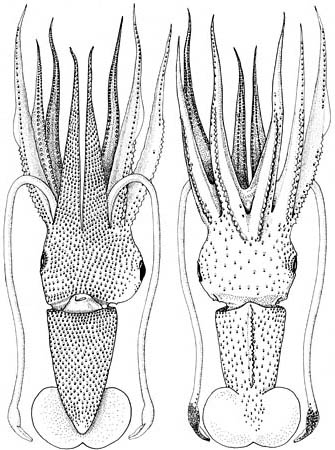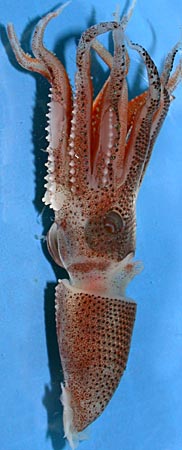Histioteuthis meleagroteuthis
Richard E. Young and Michael VecchioneIntroduction
Material of Histioteuthis meleagroteuthis examined by Voss et al. (1998) and earlier workers cited therein found no indication of population differentiation over the broad geographical, but interrupted, range of this species. However some variation in the sucker enlargement pattern of the club is a possible exception. Additional squid are needed to evaluate the latter. Also, descriptions of spermatophores from different geographical regions are needed.
Brief diagnosis:
A Histioteuthis ...
- with 8-10 series of photophores on arm IV.
- with tubercules.
Characteristics
- Head
- Beaks: Descriptions can be found here: Lower beak; upper beak.
- Beaks: Descriptions can be found here: Lower beak; upper beak.
- Arms
- Tubercules form serrate ridge along aboral midline proximally on arms I-III. on middorsal line on anterior 1/2-2/3 of mantle beneath epithelium and on proximal half of arms I-III.
- Mantle
- Tubercules form serrate ridge along middorsal line on anterior 1/2-2/3 of mantle beneath epithelium and on proximal half of arms I-III.
- Tubercules form serrate ridge along middorsal line on anterior 1/2-2/3 of mantle beneath epithelium and on proximal half of arms I-III.
Comments
More details of the description can be found here.Species of the meleagroteuthis-group are distinguished by the following characteristics:
- Photophores
- In 8-10 series on arm IV base.
- Usually 19-22 photophores on right eyelid.
- Compound photophores of uniform size, small and densely packed on anterior 3/4 of ventral mantle.
H. meleagroteuthis is easily separated from the other member of the meleagroteuthis-group, H. heteropsis, by the presence of tubercles.
The above information is taken from Voss (1969) and Voss, et al. (1998).
Life History
Females mature at 114 mm ML (spent female, 27°S, 37°W); males at 65-102 mm ML (Voss, et al., 1998).Distribution
Geographical distribution
Type locality: South Pacific, north of New Zealand at 35°45'S, 176°20'E, 549-686 m depth.
H. meleagroteuthis has been taken throughout much of the world's tropical and subtropical waters. However, it appears to be absent from the oligotrophic subtropical waters south of Bermuda, the Gulf of Mexico and Caribbean Sea in the Atlantic and transitional waters of the California and Peru-Chile currents (habitat occupied by its close relative H. heteropsis) and the northern tropical central waters around Hawaii in the Pacific (Voss, et al., 1998).
References
Voss, N. A. 1969. A monograph of the Cephalopoda of the North Atlantic: The family Histioteuthidae. Bull. Mar. Sci., 19: 713-867.
Voss, N.A., K. N. Nesis, P. G. Rodhouse. 1998. The cephalopod family Histioteuthidae (Oegopsida): Systematics, biology, and biogeography. Smithson. Contr. Zool., 586(2): 293-372.
Title Illustrations

| Scientific Name | Histioteuthis meleagroteuthis |
|---|---|
| Reference | Voss, N. A. 1969. A monograph of the Cephalopoda of the North Atlantic: The family Histioteuthidae. Bull. Mar. Sci., 19: 713-867. |
| Acknowledgements | Printed with the Permission of the Bulletin of Marine Science |
| Sex | Male |
| View | Ventral and dorsal |
| Copyright | © 2004 Bulletin of Marine Science |
| Scientific Name | Histioteuthis meleagroteuthis |
|---|---|
| Comments | Photographed aboard the R/V G. O. SARS, Mar-Eco cruise, central North Atlantic. |
| View | Lateral |
| Size | 26 mm ML |
| Image Use |
 This media file is licensed under the Creative Commons Attribution-NonCommercial License - Version 3.0. This media file is licensed under the Creative Commons Attribution-NonCommercial License - Version 3.0.
|
| Copyright |
© 2004

|
About This Page
Drawings from Voss (1969) printed with the Permission of the Bulletin of Marine Science.

University of Hawaii, Honolulu, HI, USA

National Museum of Natural History, Washington, D. C. , USA
Page copyright © 2013 and
 Page: Tree of Life
Histioteuthis meleagroteuthis .
Authored by
Richard E. Young and Michael Vecchione.
The TEXT of this page is licensed under the
Creative Commons Attribution-NonCommercial License - Version 3.0. Note that images and other media
featured on this page are each governed by their own license, and they may or may not be available
for reuse. Click on an image or a media link to access the media data window, which provides the
relevant licensing information. For the general terms and conditions of ToL material reuse and
redistribution, please see the Tree of Life Copyright
Policies.
Page: Tree of Life
Histioteuthis meleagroteuthis .
Authored by
Richard E. Young and Michael Vecchione.
The TEXT of this page is licensed under the
Creative Commons Attribution-NonCommercial License - Version 3.0. Note that images and other media
featured on this page are each governed by their own license, and they may or may not be available
for reuse. Click on an image or a media link to access the media data window, which provides the
relevant licensing information. For the general terms and conditions of ToL material reuse and
redistribution, please see the Tree of Life Copyright
Policies.
- Content changed 16 July 2006
Citing this page:
Young, Richard E. and Michael Vecchione. 2006. Histioteuthis meleagroteuthis . Version 16 July 2006 (under construction). http://tolweb.org/Histioteuthis_meleagroteuthis/19810/2006.07.16 in The Tree of Life Web Project, http://tolweb.org/











 Go to quick links
Go to quick search
Go to navigation for this section of the ToL site
Go to detailed links for the ToL site
Go to quick links
Go to quick search
Go to navigation for this section of the ToL site
Go to detailed links for the ToL site